Eurosprinteristics – A general outline of contemporary Siemens electric locomotives
Evening all!
As I indicated a few months ago, I have been planning to restructure my blog postings about Siemens Eurosprinter type locomotives in a similar manner as those about Bombardier TRAXX type locos, with one general technical description to give an overview and reference about common and especially noteworthy design characteristics, and separate articles highlighting specific examples for Eurosprinter type locos. This entry will be the "baseline" technical portrait.
Strictly speaking, the Eurosprinter product line originated in the late 1980s, when the Spanish class 252 locomotives were created. While the type name of „Eurosprinter“ was not actually coined until 1992, these locos did represent the first major step for Siemens towards creating a unified technical platform from which locomotives could be adapted for individual technical and operational requirements. The Spanish 252s, delivered from 1991 till 1996, were still closely related to the German class 120 electrics, as were the Portuguese class 5600 engines which were procured between 1993 and 1995. While the 252 was configured both in a 3 kV DC only, broad gauge version and a dual 25 kV AC/3 kV DC standard gauge version also capable of working Spain‘s newly built high speed lines which were opened from the early 1990s onwards, the Portuguese 5600s are equipped for the 1,668 mm Iberian broad gauge and 25 kV AC only.
In 1992, Siemens presented the actual prototype for what was now called the Eurosprinter locomotive family. Externally, this loco, given the running number 127 001 and designated ES 64 P, closely resembled the Portuguese 5600s and Spanish 252s, but had a slightly shorter body and was fitted with standard gauge bogies and for 15 kV AC only. After initial route trials, the loco was used in scheduled passenger and freight service, with Siemens hoping to attract further orders from either Deutsche Bundesbahn or other European railways. However, the Greek railways turned out to be the only customer for these 1st generation Eurosprinter type locomotives, ordering a total of thirty units with a slightly reduced maximum power output of 5,000 kW and 25 kV AC capability. The first six locos, procured in 1997, were originally designated class H – „eta“ – and numbered 561 through 566, with the remaining twenty-four being designated class 120 and delivered in 2004 and 2005. The original H class locos were eventually integrated into the same class.
Meanwhile, the German 127 001 was purchased by Siemens for their Dispolok motive power leasing pool, which in turn was later sold to MRCE. At this time, 127 001 is still operational, now being part of the inventory allocated to the Siemens Test Centre at Wegberg-Wildenrath. Aside from duties related to evaluating and certifying newly designed motive power, it is often assigned to locomotive deliveries as well.??In 1994, newly formed Deutsche Bahn then ordered 195 units of a new type of locomotive derived from the 127, but tailored for freight work and also known as the ES 64 F type. However, the number of orders was later reduced to 170. These locomotives, which were delivered between 1996 and 2001, were designated class 152 and originally intended to fully replace the class 150 and 151 Co'Co' locomotives, but effectively replacing only the former. As they were also fitted with push-pull controls, ETS and other equipment required for passenger workings, their early service years also saw them on occasional semi-fast regional workings and charter services. Aside from the 170 152s for Deutsche Bahn – now owned by DB Schenker – , two additional locos were built and initially added to the Dispolok pool, but later sold to freight operator ITL. The German class 152 electric also served as the basis for the South Korean class 8100, 8200 and 8300 locos, as well as the Danish class EG dual voltage electrics, though the latter is a Co‘Co‘ configured locomotive.
While DB Cargo – as Deutsche Bahn‘s freight branch was called at the time before changing their name first to Railion and eventually DB Schenker – intended to have the 152s certified for Austria as well, the Austrian network authorities refused this clearance on the grounds of the 152 supposedly causing excessively high wear on the roadbed and track. ??During this time, the Austrian Federal Railways (ÖBB) had also decided in favour of massively renewing their motive power inventory. As part of this process, ÖBB were planning to obtain large numbers of modern AC electric locomotives, to which end Austrian loco builders Simmering-Graz-Pauker, ABB, ELIN and the national Siemens branch proposed the class 1012 Bo‘Bo locomotives. While three prototypes were built, trials revealed them to essentially have been over-engineered and excessively expensive to procure, so a new tender resulted in Krauss-Maffei and Siemens jointly winning the contract for an intended total of 400 class 1016 15 kV only and class 1116 15 and 25 kV dual voltage locomotives. Designated ES 64 U2 and capable of 230 kph, these locos quickly proved to have been designed exceptionally well, and were also sold to numerous other operators. However, ÖBB would eventually adjust their orders down to a total of fifty class 1016 and 282 class 1116 locos as they had determined a need for an evolved electric loco also capable of operating on DC networks, such as Italy with its 3 kV DC electrification. The 1016s and 1116s are also well known under their ÖBB trademark name „Taurus“, which, strictly speaking, may only be used for ÖBB‘s locomotives.
The ES 64 U2 type but also provided DB Cargo with a solution to the problem of their 152s not receiving clearance for Austria, causing the company to have the final 25 orders for 152s changed into ES 64 U2 type locos, designated class 182. Most recently, the 182s have but all been sold to DB Regio for semi-fast and stopping services in Saxony, including suburban services around Dresden.
In 2003, responding to ÖBB and other operators desiring an evolved four-system Eurosprinter variant, Siemens rolled out the ES 64 F4 type, again optimised for freight work and with a design speed of 140 kph. This type – best known as class 189 as per Deutsche Bahn‘s designation – also took the idea of modularity to the next level, with Siemens offering an ever-growing number of country packages consisting of different arrangements of train protection systems and pantographs.
The ES 64 F4 type also served as the basis for yet another evolutionary step. In 2005, Siemens presented the ES 64 U4 type, which in turn is best known by its Austrian designation as class 1216. Technically, this type is basically a hybrid of the ES 64 F4‘s four-system electric setup with a „Taurus“ style aerodynamic body and high speed bogies, again offering a top speed of 230 kph and thus maximum versatility for universal mixed traffic service.
The two most recent developments to follow the ES 64 U4 type have been the „Eurosprinter 2007“ type, again with a redesigned body to meet the latest European crashworthiness standards, and finally the Vectron family. Eurosprinter 2007 type locos have been built for the Belgian railways as classes 18 and 19, and for the Portuguese railways as class 4700, while the first Vectron type locos are just being delivered at this time. Similarly to Bombardier‘s approach on their TRAXX platform, the Vectron family allows both fully electric and diesel-electric locomotives to be built using the same basic body and bogie design, and with different power ratings and country packages to suit specific operator requirements.
As several of the Eurosprinter‘s design features have been modified over the course of the years, any technical description I could provide will largely be centred on common items which remained fundamentally unchanged across the various types.
Generally speaking, the locomotive body is a fully welded steel assembly, with specific elements – such as doors, ventilation grilles or snow ploughs – being made of aluminium, or indeed composite materials, as in the case of the aerodynamically shaped cab roof elements on the ES 64 U2. It is based on a running frame consisting of one central and two outer longitudinal main beams, two outer transversal beams also serving as bufferbeams, as well as two transversal bogie support beams and transformer support beams each. Additional underfloor bracings are provided for added stability. Meanwhile, the body structure itself consists of the engine room side walls with topside longitudinal roof support beams, the rear cab bulkheads with upper transversal roof support beams, and the cab sections proper, which are all-steel assemblies on the ES 64 F, ES 64 F4 and U4 types. The roof is divided into independently removable aluminium sections to facilitate removal of bulky internal installations, such as the inverters, cooling towers and other major items. There are three sections on the ES 64 F4 and U4 which also include the pitched lateral planes and ventilation grilles, and four on the ES 64 F and U2, where the lateral planes and ventilation grilles are part of the body proper. Draw gear consists of the usual arrangement of UIC chain link couplers and buffers, the latter of which are designed to also serve as impact protection elements.
The bogies are designed in accordance with the intended operational profile for the specific loco type. Generally speaking, freight locomotives like the ES 64 F and F4 types utilise nose-suspended traction motors with cheek brake disks on the outer and inner wheel faces, while mixed traffic types such as the ES 64 U2 and U4 have hollow shaft drivetrains with fully suspended traction motors and a separate brake shaft per wheelset, which is geared to the wheelset proper and suspended independently of it to reduce unsprung masses. However, either bogie design is based on a frame with two outer longitudinal beams with depressed centre sections, one central transversal beam and two outer transversal beams. The outer beam facing towards the cab is designed to also double as a dozer blade to keep items to about the size of a large branch away from the wheelsets. In addition, larger snow ploughs are also provided below either bufferbeam, the size and exact shape being different between the ES 64 F, U2 and U4 on one hand and the F4 on the other hand. With Siemens having chosen to prefer a pivot pin setup on their locomotives as opposed to traction bars as used by Bombardier, the bogie pin bearing is located towards the bottom of the bogie within the central transversal beam to ensure even axle load distribution under difficult high power/heavy train load conditions. The axleboxes contain roller bearings for the wheelsets and are attached to the bogie frame with rubber-dampened single-sided levers, with those used on the ES 64 U2 and U4 types also allowing a degree of radial adjustment to further enhance running abilities. Both primary and secondary suspension are provided by helical springs, while hydraulic motion dampers provide vertical stabilisation for the axleboxes, and both vertical and rotational stabilisation for the bogies as a whole.
The wheelsets consist of hollow-bored shafts and Monobloc wheels pressed onto the shafts, with one wheel per wheelset on the ES 64 U2 and U4 serving to accept power from the motor gearbox, and thus carrying three pairs of bolts to be connected to the annular coupling element on the hollow shaft. Also on the ES 64 U2 and U4, noise absorbers are attached to the circumference of the wheel tyres, though more specifically, different absorbers had been utilised over the years. On the ES 64 U2, the sickle-shaped multilayered sheet absorbers attached to the outer wheel faces had been a major distinguishing feature during the initial years, but at present, small rubber-metal composite elements are used on both types. Furthermore, the ES 64 U2 and U4 are both fitted with one transversal derailment protection beam attached to the bottom of each bogie, intended to prevent the locomotive‘s wheels from burrowing in the roadbed in the event of a derailment, and to keep the loco upright.
Braking gear consists of one pair of pneumatically actuated callipers per wheelset, clasping either the cheek brake disks on the wheel faces on ES 64 F and F4 type locos, or the brake disks attached to the brake shafts on the ES 64 U2 and U4. The brake valves are common unified Knorr types with settings G, P and R, and both direct and indirect controls. All Eurosprinter types are also equipped with spring-load devices to serve as arresting brakes. As with all contemporary electrics, the dynamic and pneumatic brakes are blended, with the dynamic brake taking precedence for as long as possible. On the ES 64 F4 and U4 types, the dynamic brake can work both in regenerative mode under AC power, and under both regenerative and rheostatic mode under DC power, depending on the amount of energy which the grid can accept. To that end, these two types are equipped with one additional pair of cooling towers for the braking rheostats.
Also on all Eurosprinter types, the transformer is hung below the floor between the bogies and oil-cooled, the power output depending on the loco type. The engine room is designed to accommodate all electric and pneumatic installations in cabinets and racks on either side of a centrally located corridor. The traction inverters are located immediately above the transformer to ensure short transmission conduits, are liquid-cooled and consist of GTO thyristor modules on the ES 64 F and U2, and of IGBT modules on the ES 64 F4 and U4. Other items located in the engine room include one cooling tower per traction motor, the compressor and the pneumatic brake armatures.
The circuit breakers generally are vacuum types, and set towards the Cab 2 end, either inside the loco‘s body on the ES 64 F, or on the rooftop on the U2, F4 and U4. On the ES 64 F, the busbar is also located inside the roof, and again on the roof on all other Eurosprinter types. AC pantographs generally are Siemens-designed SSS 87 and SBS 2T types, with DC pantographs for the ES 64 F4 and U4 types being either Schunk WBL85 types for locos configured for Italy, and again Siemens SBS 2T derivatives for all other DC networks.
The cabs are fundamentally derived from the unified Deutsche Bundesbahn layout introduced on the class 111 and 120 electrics. The driver is sat on the right, while a secondman‘s seat is provided on the left-hand side. While details do differ between the various Eurosprinter types, the following image taken aboard a DB Schenker class 189 loco should be suitable to illustrate the general layout encountered on all types.
On all Eurosprinter type locos, the windscreen consists of two separate panes. The cabs are generally air-conditioned, while the door arrangement differs between the ES 64 U2 and all other types. On the ES 64 U2, only one door per loco side is provided, these doors being located in the engine room, with the idea here having been to reduce draft and improve workplace comfort. Meanwhile, there also is one lateral escape hatch per cab on this type, located near the floor behind the driver‘s position. However, all other Eurosprinter types have two conventionally positioned doors, one of each side of the cabs. On the ES 64 U2 and U4, fold-out rear view mirrors are provided on either side of the cabs, while the F4 type has rear view cameras located immediately behind the cab doors on locos configured for countries where rear view aids are mandatory. Being configured for Germany only, the ES 64 F type has no rear view aids at all, as these may not be used while a train is in motion as per German operating rules.
And as the final segment for this overview about Eurosprinter type electrics, I should like to provide a couple of photos from my collection, showing those classes from this product line I have been able to capture over the years. Unfortunately, ES 64 U4s have eluded me completely thus far, as has the prototype 127 001.
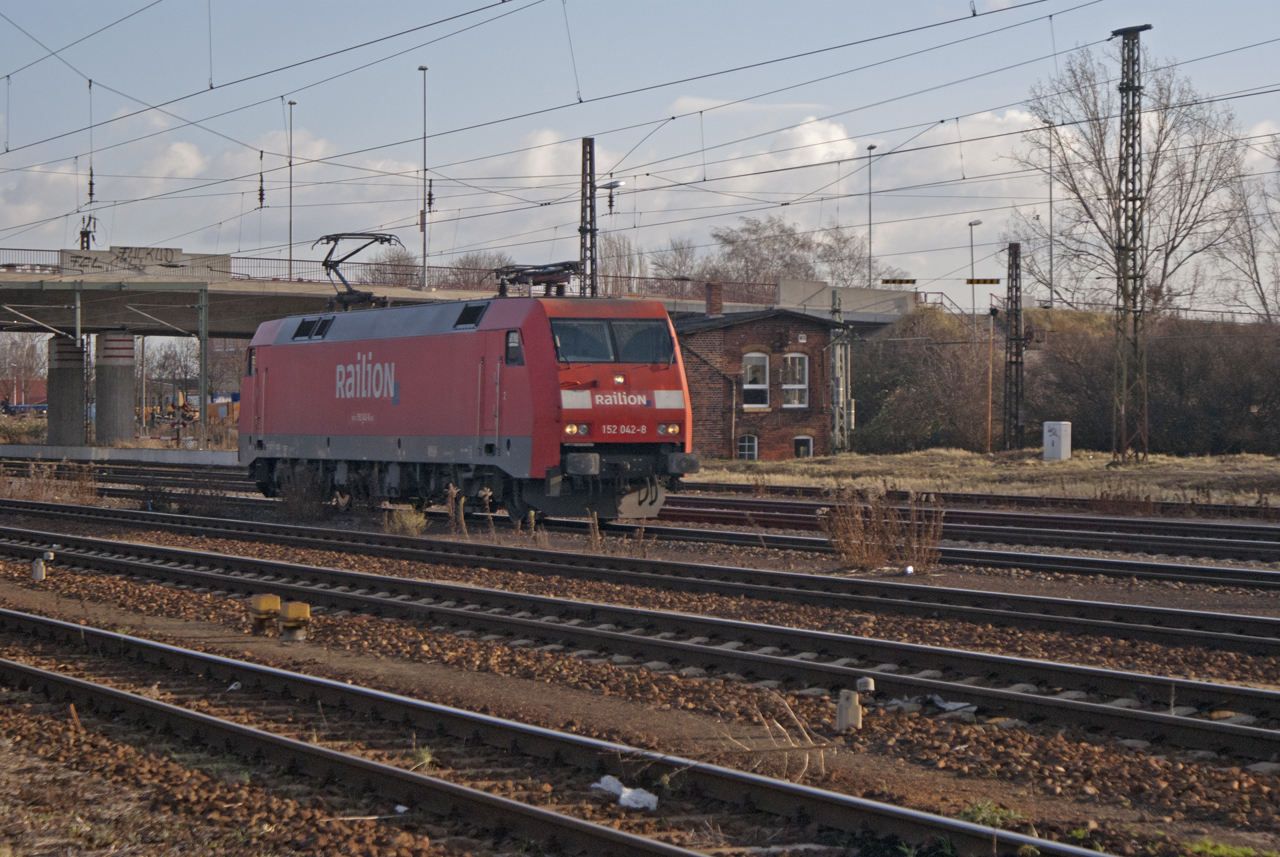
As the sun was beginning to set on 29 December 2011, 152 042 – still to be refitted with additional tread plates and grab rails on the fronts – was rolling into the Engelsdorf yard, almost escaping my camera!
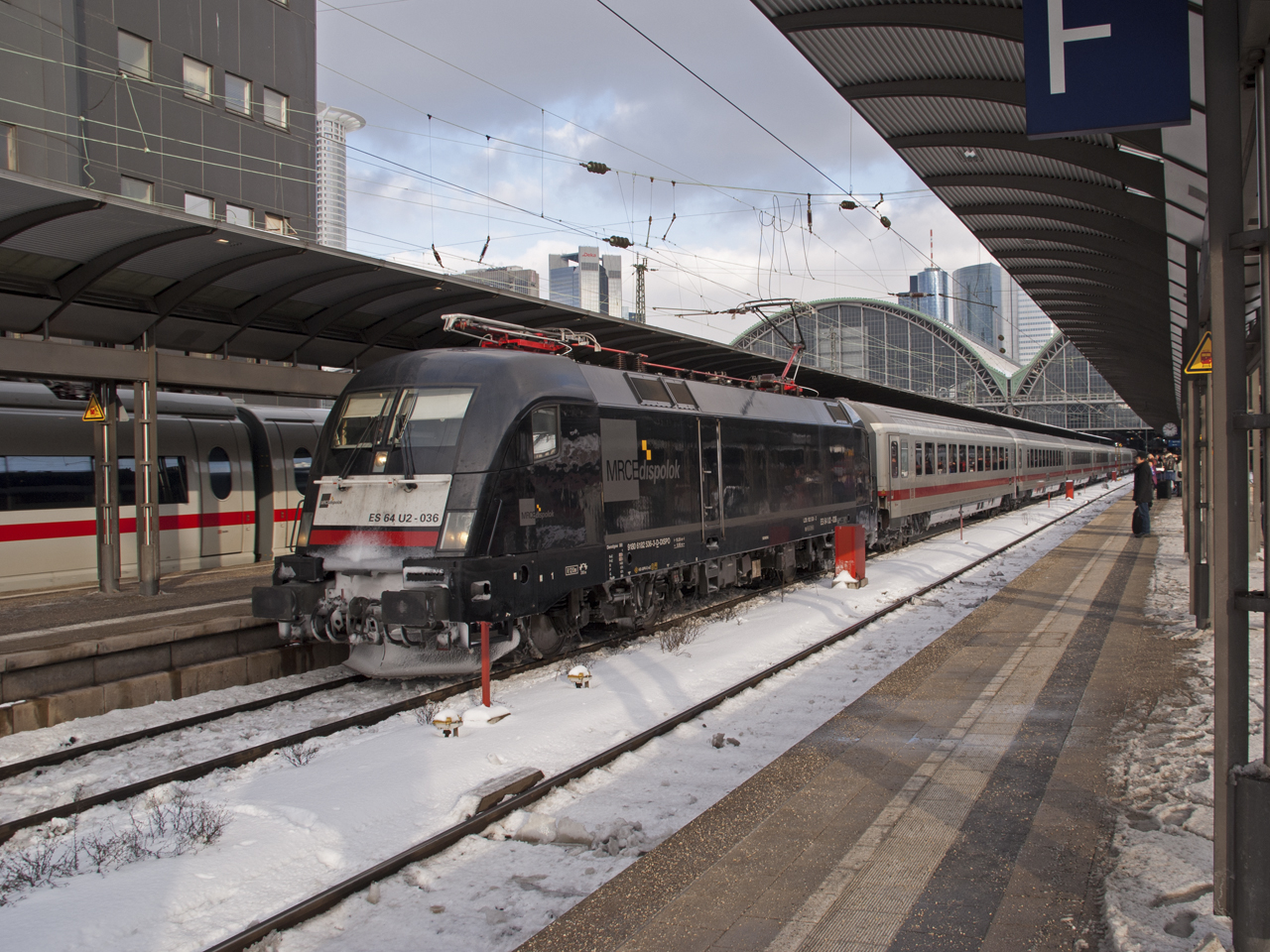
For the last three to four years, Deutsche Bahn have leased various numbers of locomotives from MRCE Dispolok to augment their motive power pool – one reason having been an increased need for loco-hauled formations following tightened servicing intervals on most of the ICE fleet. In 2010, 182 536/ES 64 U2-036 was among those reinforcements, and is seen here in a top-and-tail setup on a rake of classic InterCity coaches with 182 534 up back.
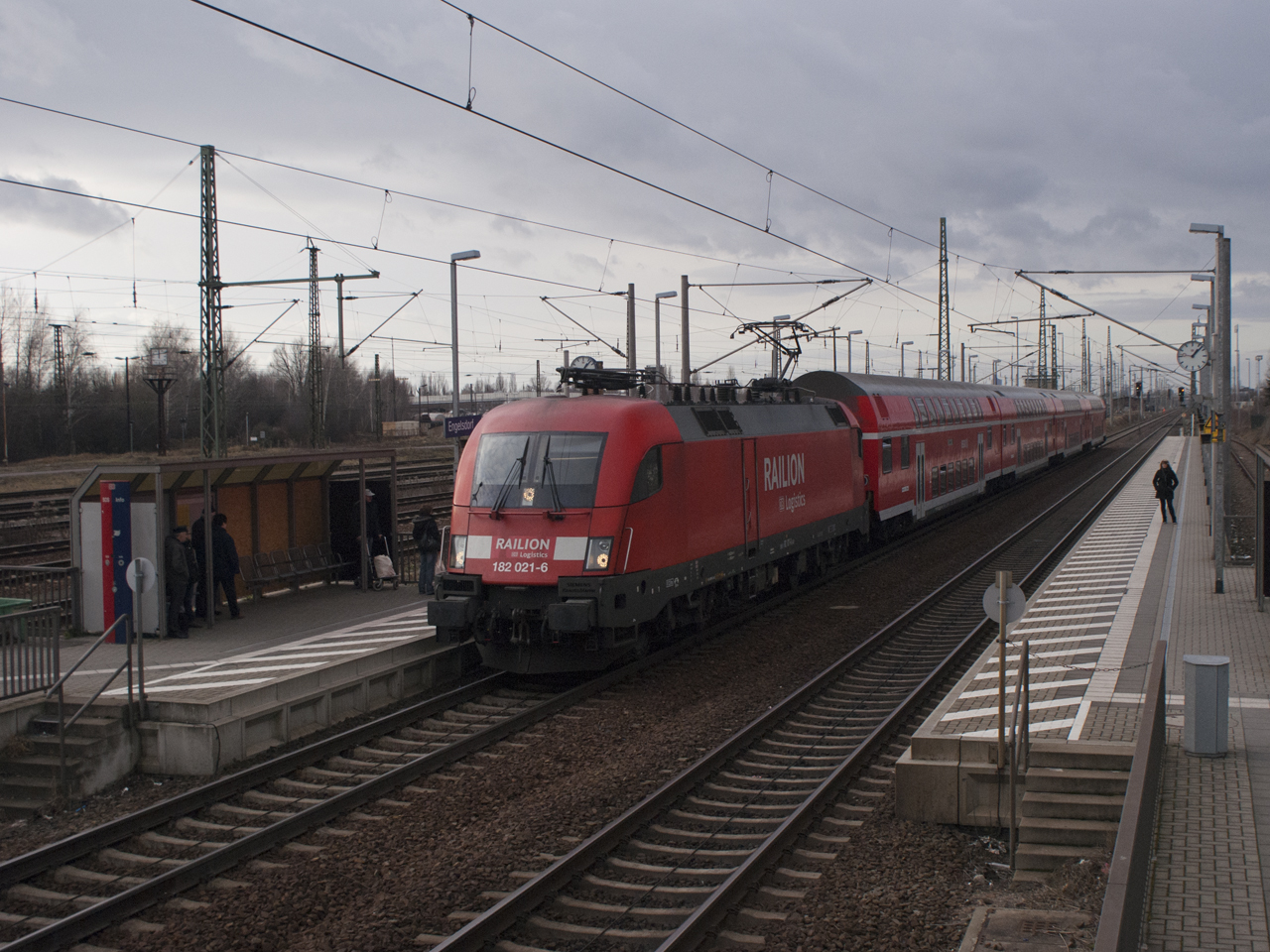
As I mentioned further up, DB Cargo had obtained a total of 25 class 182/ES 64 U2 type locos for their Austrian operations. However, due to an increasing number of 185s having been certified for Austria, it was eventually decided to sell these locos to DB Regio, who are now using them on semi-fast and stopping services in the Saxony/Thuringia area, as well as on suburban services around Dresden. Here, 182 021 – still wearing Railion markings – is seen at Engelsdorf Station on the eastern outskirts of Leipzig, heading an express service to Dresden.
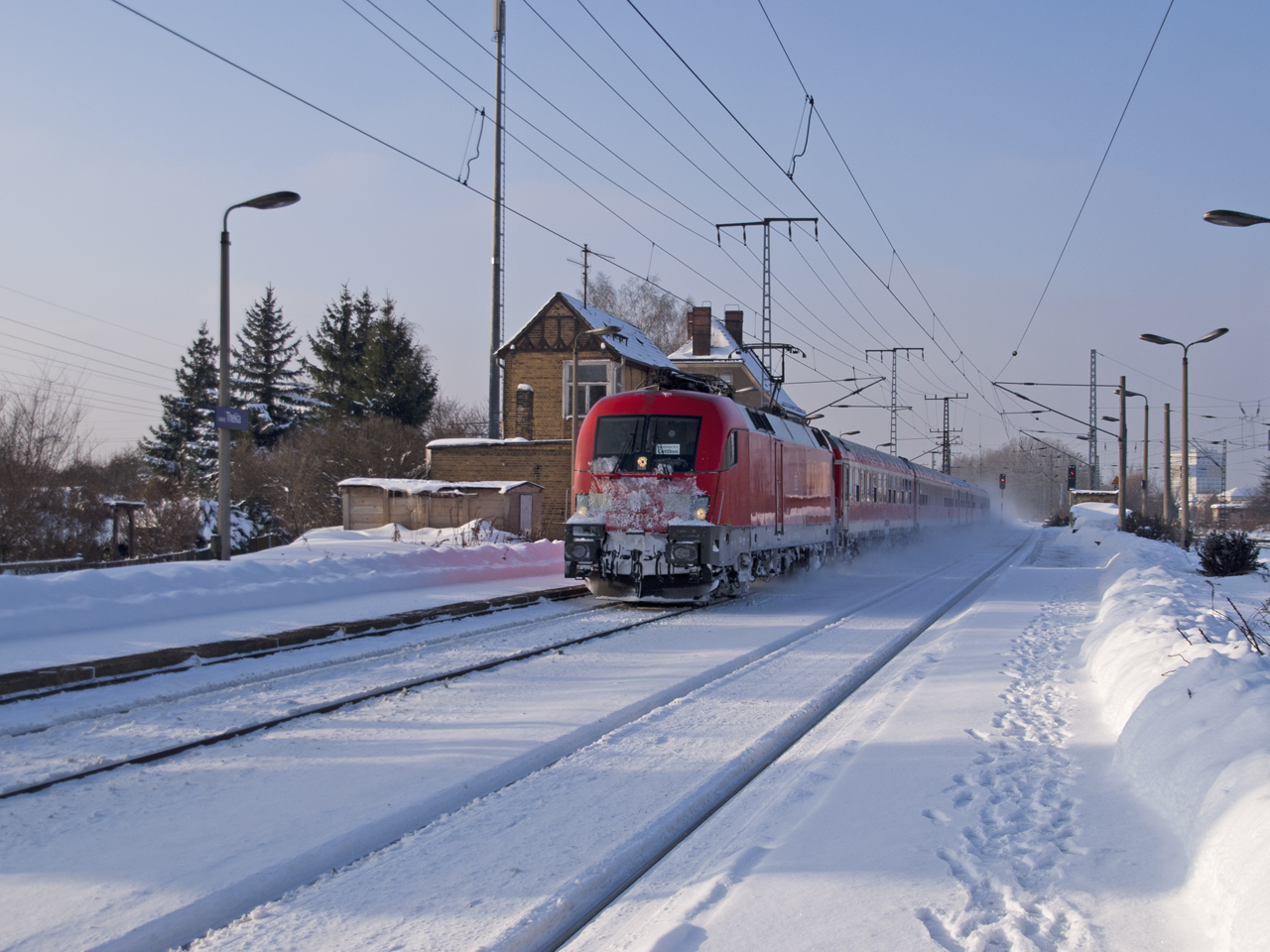
Following the severe snow which came across Germany at the end of 2010, 182 003 is seen here working a semi-fast service to Cottbus at Thekla Station in the northeast of Leipzig.
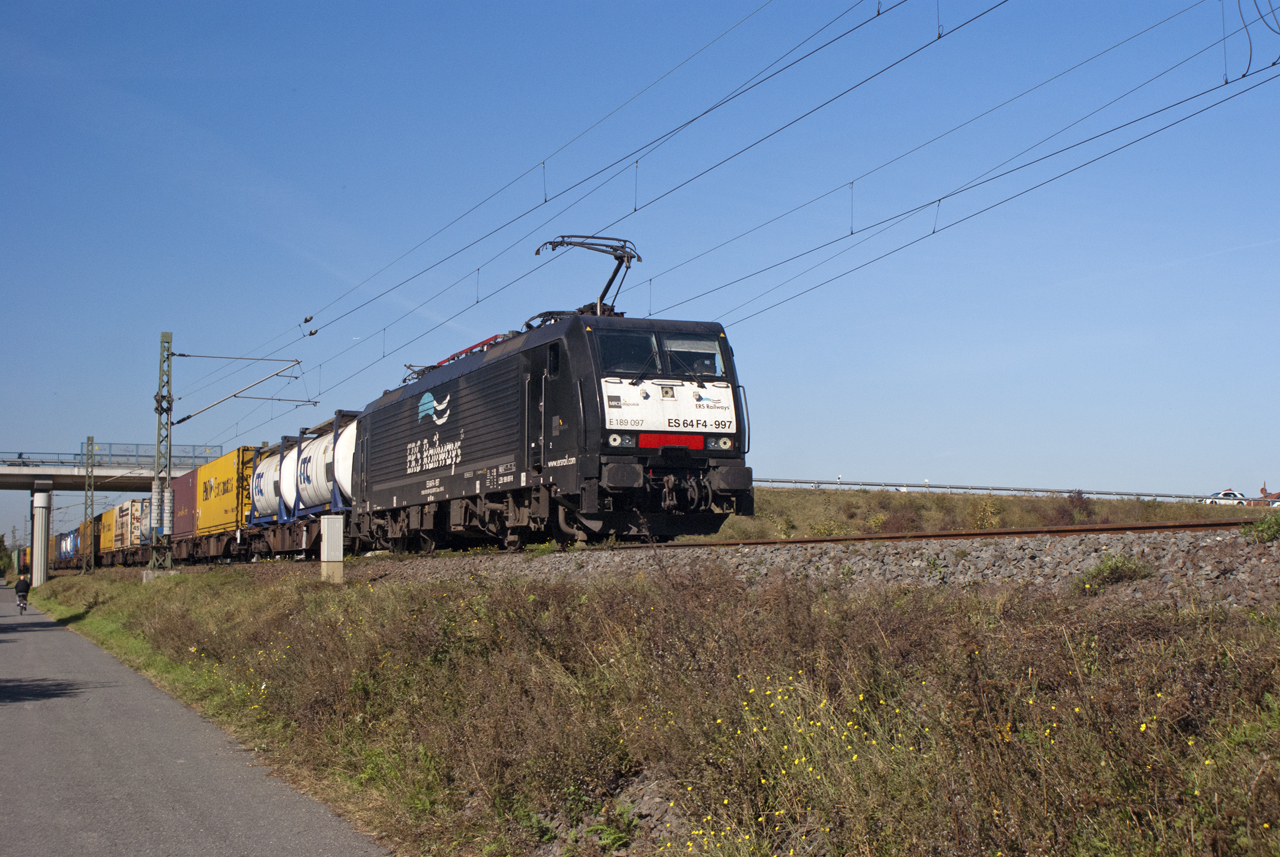
An ES 64 F4 type loco, 189 097 is owned by leasing company MRCE Dispolok and wearing markings for Dutch freight operator ERS Railways. This is one of the ten locomotives MRCE bought from DB Schenker, seen here working a container service near Nauheim on the Rhine-Main Railway – also known as Route 651.
Plus a handful of suitable Youtube videos showing several of the above loco types in action...
http://www.youtube.com/watch?v=QkU_SHNptuk
http://www.youtube.com/watch?v=UTPLnhaFMxU
http://www.youtube.com/watch?v=ZUyMzpwqIhE
http://www.youtube.com/watch?v=jGGGgsJRvAM
http://www.youtube.com/watch?v=XCPMtwy7KEQ
http://www.youtube.com/watch?v=MTJTreU2LiI
http://www.youtube.com/watch?v=tH0qB9Y1duc
http://www.youtube.com/watch?v=llCNlE6IHPU
http://www.youtube.com/watch?v=m2Q3FdreFbI
http://www.youtube.com/watch?v=CrUWzMS17Gk



0 Comments
Recommended Comments
There are no comments to display.
Create an account or sign in to comment
You need to be a member in order to leave a comment
Create an account
Sign up for a new account in our community. It's easy!
Register a new accountSign in
Already have an account? Sign in here.
Sign In Now